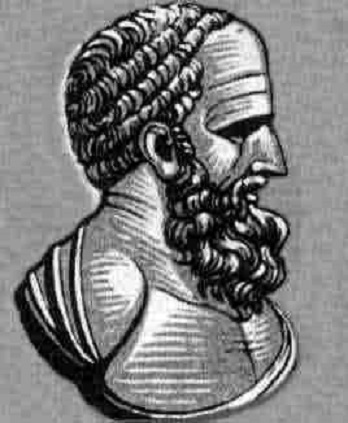
Hipparchus

Hipparchus of Nicea (190 BCE - 120 BCE) was an ancient Greek mathematician, astronomer and geographer, regarded by many historians as a scientist of the highest quality and possibly the greatest astronomical genius among the ancient Greeks. Basing most of his success on systematically exploiting the Chaldean and Babylonian astronomical knowledge and techniques, many of his achievements in astronomy remained widely accepted for 17 centuries.
HISTORICAL CONTEXT
Around Hipparchus' time, Aristotelian cosmology dominated Greek thought. This model was based on the idea that the earth was the centre of the universe and that circular planetary motions were perfectly uniform. However, it was a rigid model that could not account for certain observations such as the changes in the brightness of the planets, their retrograde motions, and changes in their speeds: these observations clearly contradicted the Aristotelian model. This gap between theory and observation, though, was not significant among Greeks until Alexander the Great conquered the East and Greek geometrical astronomy began to merge with the observational-based Babylonian astronomy.
The Babylonians for centuries kept accurate astronomical observational records and they also had arithmetical tools and a numeral system for writing numbers with sixty as its base, all of which was unknown to the Greeks: Hipparchus incorporated these innovations into Greek thought and, based on the Babylonian numeral system, started to divide circles into 360 degrees. The old mathematical prejudice of uniform circular planetary motion was too strong to be discarded but now there was a greater concern for observational facts.
The flexibility lacked by the Aristotelian model was partially overcome by two geometrical tools created by Apollonius of Perga around 200 BCE. He suggested replacing the conventional circles by eccentric circles. In an eccentric circle the planets moved as usual in a uniform circular motion around the earth, but our planet was not the centre of the circle, rather, offset the centre. This way, the planet’s speed changes could be accounted for and also the changes in brightness: planets would appear to move faster, and also brighter, when they were nearer the earth, and slower, and also dimmer, when they were away on the far side of their orbit. Apollonius came up with an additional tool, the epicycle, an orbit within an orbit (the moon revolves around the earth and the earth orbits the sun or, in other words, the moon moves around the sun in an epicycle). This device could also account for changes in brightness and speed but it could also account for the retrograde motions of the planets which had puzzled most Greek astronomers.
HIPPARCHUS' CONTRIBUTIONS
Only one of his many works has survived, a commentary on the Phainomena of Eudoxus and Aratus of Soli. Most of his ideas in astronomy are known to us through Claudius Ptolemy’s work Almagest, a massive astronomical essay completed during the 2nd century CE which remained as the standard reference for scholars and unchallenged until the Renaissance. The Almagest is mainly based upon Hipparchus calculations and research.
Hipparchus created the discipline of trigonometry. He calculated the length of the lunar month with an error of less than one second and estimated the solar year with an error of six minutes. He also improved the main astronomical instruments of his time (the astrolabes and quadrants). Hipparchus proposed that the difference in longitude between cities could be accurately determined by comparing the local times of an eclipse of the moon, viewed simultaneously from the two locations.
We owe to Hipparchus the general rejection of the sun-centred planetary system proposed by Aristarchus of Samos during the 3rd century BCE. Hipparchus concluded that the geocentric model better explained the observations than did the model of Aristarchus. The only way the sun-centred model could stand mathematical analysis was by supposing an elliptical orbit of the earth, and this supposition was something that Hipparchus was not willing to accept, since it was established consensus among astronomers at that time that the planetary orbits were circular. On top of this, Aristarchus' model expanded the size of the universe far beyond the accepted size, which was also an implication difficult to accept. On the other hand, Hipparchus improved the calculations of Aristarchus of the sizes and distances of the sun and moon: he calculated the distance of the moon from the earth with an error of only five per cent.
It is tempting for us to believe that Hipparchus brought science one step backwards by rejecting the heliocentric model, however, Hipparchus actually tested the heliocentric model and his rejection was supported by mathematical evidence as far his understanding was concerned. After all, it is not what a man believes which defines him as a scientist, it is the why: his conclusions have to be consistent with what the evidence suggests. We could blame him for blindly accepting the idea of circular uniform planetary motion and not being open to considering other possibilities but in fairness the notion of circular uniform planetary motion was, for ancient Greek astronomers, as strong as we today believe our planet is sphere-shaped. Every society is encompassed by a cloud of paradigms which tend to remain unchallenged for many generations. Even the most talented minds do not always manage to overcome this set of comforting convictions.

(HIPPARCHUS MEASUREMENT OF THE DISTANCE TO THE MOON)
It was Hipparchus who used and perfected the geometrical tools proposed by Apollonius of Perga in order to eliminate most of the contradictions of the geocentric model. Based on these devices he performed a number of refinements in the model which allowed sufficient observational accuracy for it to be accepted for the next centuries. These refinements encouraged the progress of the geocentric model, but never achieved total success. Astronomy would have to wait for Kepler (17th century CE) to come up with a fully successful planetary model able to describe the motions of the sky.
Hipparchus perfected the method of Eratosthenes for charting the Earth’s surface. He decided to mark off lines completely around the sphere parallel to the equator and at equal intervals. Then he marked off other lines at right angles to these spaced equally at the equator. The result was a regular grid covering the entire globe. He also numbered all of these lines and, thus, it was possible to determine terrestrial positions by following a simple set of coordinates. He tried to organize the astronomers of the Mediterranean to record all information that would help to determine the location of all important cities. However, during that time the level of political order and cooperation required for such a task could not be realised. Hipparchus had, however, set the the basic pattern for mankind’s cartographic mastery of the planet.
MEASURING THE EQUINOCTIAL PRECESSION
If we stand at any point of our planet on the 21st of March (spring equinox in the northern hemisphere), shortly before dawn, and look due east, we will see a constellation sitting on the horizon in the place where the sun will shortly rise. That constellation today is Pisces, and it has been so roughly for the last two thousand years. Within the next couple of hundred years, this constellation will be Aquarius. The reason for this change is an almost imperceptible wobble on the axis of the earth which causes the sun to move backwards as a pointer against the constellations, gradually tracking backwards one degree every 72 years or so. This gradual retrograde shifting of the stars is known as the Precession of the Equinoxes.
One evening, Hipparchus noticed the appearance of a star where he was certain there had been none before. It was critical for him to determine whether this appearance was real, since heavenly bodies at that time were believed to be unchanged and not subject to either creation or destruction. Determined to certify possible later changes, he made a catalogue of the sky providing the positions of 1080 stars by stating their precise celestial latitude and longitude. Timocharis, 166 years before Hipparchus, had also made a chart. Comparing both charts, Hipparchus calculated that the stars had shifted their apparent position by around two degrees. This is how he discovered and measured the precession of the equinoxes. He calculated the precession to be thirty-six seconds per year, an estimation a little too short according to modern calculations, which is fifty. This astronomical discovery is one of the finest of all his discoveries. Countless pages have been written on whether Hipparchus was the very first to know about the equinoctial precession. Some scholars believe that the Babylonian astronomer Kidinnu, during the 4th century BCE, already knew about it but certainly Hipparchus' was the first mind in Greek tradition to discover it.
BIBLIOGRAPHY
Boorstin, D.J, The Discoverers (Vintage, 1985).
Durant, W, The Life of Greece (Fine Communications, 1997).
Hoskin, M, The History of Astronomy (Oxford University Press, 2003).
Sagan, C, Cosmos (Ballantine Books, 1985).
[1]
Sources
[1] "Ancient History Encyclopedia" by Cristian Violatti
Our Mobile Application
Check out Our Mobile Application "Ancient Greece Reloaded"


